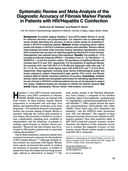Systematic review and meta-analysis of the diagnostic accuracy of fibrosis marker panels in patients with HIV/hepatitis C coinfection.
HIV clinical trials
Shaheen AA, Myers RP
2008 HIV Clin Trials Volume 9 Issue 1
PubMed 18215981 DOI 10.1310/hct0901-43
BACKGROUND
Accurately staging hepatitis C virus (HCV)-related fibrosis is crucial for treatment decisions and prognostication. Our objective was to systematically review studies describing the accuracy of serum marker panels for predicting fibrosis in HIV/HCV-coinfected patients.
METHOD
Studies comparing serum marker panels with biopsy in HIV/HCV-coinfected patients were identified. Random effects meta-analyses and areas under summary receiver operating characteristics curves (AUC) examined test accuracy for detecting significant fibrosis (F2-4) and cirrhosis. Heterogeneity was explored using meta-regression.
RESULTS
Five studies (n = 574) including four fibrosis measures (APRI [n = 4 studies], Forns' [n = 2], FibroTest [n = 1], SHASTA [n = 1]) met the inclusion criteria. The prevalence of significant fibrosis and cirrhosis were 51% and 16%, respectively. For the prediction of significant fibrosis, the summary AUC was 0.82 (95% CI 0.78-86) and diagnostic odds ratio was 7.8 (5.1-11.9). For cirrhosis, these figures were 0.83 (0.69-0.97) and 11.0 (4.6-26.2), respectively. Meta-regression including study factors (methodological quality and biopsy adequacy), patient characteristics (age, gender, CD4 count), and fibrosis measure failed to identify important predictors of accuracy.
CONCLUSION
Available fibrosis marker panels have acceptable performance for identifying significant fibrosis and cirrhosis in HIV/HCV-coinfected patients but are not yet adequate to replace liver biopsy. Additional studies are necessary to identify the optimal measure.
Citation Reference:

